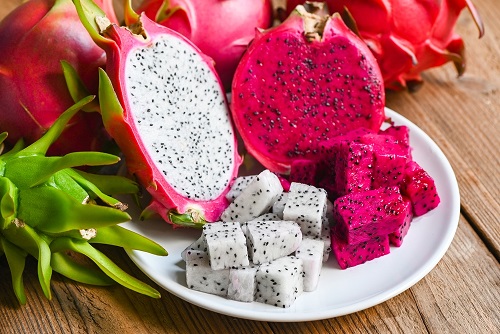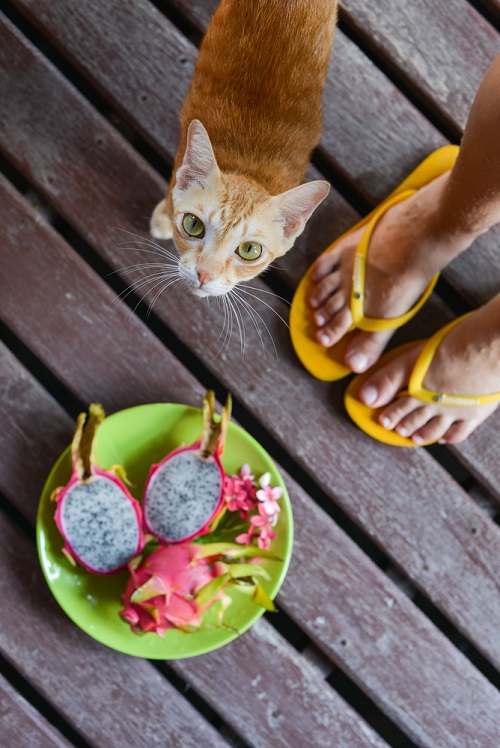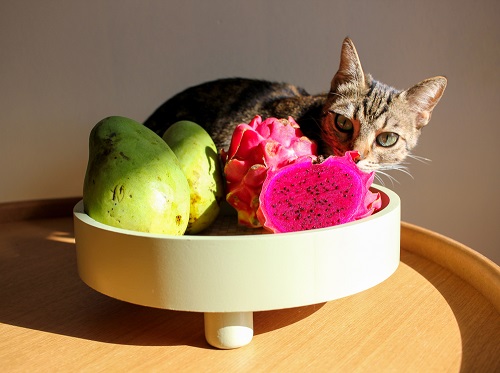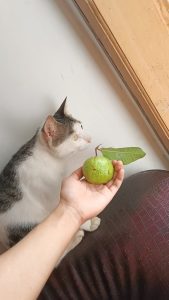If the thought of cats and fruits has crossed your mind, you are not alone. Can Cats Eat Dragon Fruit? Find out in our informative article!
The internet is full of questions about what types of food cats can eat, and dragon fruit is no exception. A popular and exotic fruit, Can Cats Eat Dragon Fruit? This article will explore the potential benefits and risks of feeding cats dragon fruit so you can make the best decision for your pet.
Can Cats Eat Pears? Find out here
What is Dragon Fruit?

Dragon fruit, also known as pitaya or pitahaya, is a tropical fruit native to Mexico and the Pacific coasts. It is a member of the cactus family and is a bright red or yellow pear-shaped fruit with white flesh and black, crunchy edible seeds.
The flavor of dragon fruit is sweet and slightly tart, with a texture similar to kiwi. It is a good source of fiber, vitamins, and minerals, including magnesium, calcium, and iron. Dragon fruit is often eaten raw but can also be used in smoothies, salads, or as a topping for yogurt or ice cream.
Can Cats Eat Dragon Fruit?
There is nothing about a dragon fruit not to like – its sweet flavor is refreshing, and it is packed with nutrients.
When it comes to cats and whether they can enjoy the juicy dragon fruit or not, the answer is maybe. Although it is not recommended for felines to eat the fruit, if fed in moderation and with care, there is no reason why cats cannot enjoy dragon fruit.
Felines do not require fruits as a part of their daily diet. So, your cat is not missing out on anything if you are not feeding it dragon fruit.
Is Dragon Fruit Toxic For Cats?
No, dragon fruit is not toxic to cats. However, cats are not able to digest some of the components in the fruit and could experience an upset stomach if too much of it is consumed.
Do Dragon Fruits Contain Any Nutritional Value For Cats?

While dragon fruit may not be suitable for cats, it can provide certain health benefits if given as a treat.
- The flesh of the fruit is rich in antioxidants (helps prevent cell damage and boost the immune system), Vitamin C (improve overall health), and B vitamin (aid in metabolism and energy production).
- The high dietary fiber content helps with digestion and can reduce the risk of constipation.
- Dragon fruit contains essential minerals like potassium, calcium, magnesium, and phosphorus, which are essential for feline health.
How To Feed Dragon Fruit To Cats?
It is important to serve the dragon fruit to cats by keeping some specific things in mind.
- Wash the fruit properly before cutting or peeling.
- Peel the dragon fruit and cut into small cubes or slices, making sure the pieces are small enough for your cat to eat.
- Serve the pieces on a plate without any additives or toppings like sugar syrups or nuts.
- Monitor your cat while it is eating the dragon fruit to ensure that it does not choke.
- If your cat does not seem interested in the dragon fruit, do not try to force-feed it.
- A cat can safely eat dragon fruit as a snack once a week in small quantities.
Can Cats Eat Dragon Fruit ? A Few Concerns
- Potential allergic reactions: Dragon fruit contains certain proteins that could cause an allergic reaction in cats, resulting in itching, sneezing, or breathing difficulties. Additionally, the presence of pesticides or herbicides on the fruit can be harmful to a cat.
- Too much sugar: Dragon fruit contains a high amount of natural sugars, which can cause stomach problems or obesity if eaten in large quantities.
- Risk of choking: The small seeds within the dragon fruit can be a choking hazard for cats, so it is important to only give them small chunks of the fruit and watch them to ensure they do not choke.
- Difficult to digest: Kittens have delicate digestive systems, so it is best to avoid giving them too much dragon fruit as it could cause digestive upset or diarrhea. The high fiber and Vitamin C content in dragon fruit can be difficult to digest for the feline gut in excessive quantities.
Can Cats Eat Dragon Fruit? Something Important!

- It is important to consult with a veterinarian before feeding a cat dragon fruit.
- Dragon fruit should not be given to cats with existing health issues, such as kidney or urinary tract problems.
- Cats should never be given dragon fruit as a substitute for a balanced diet.
- Dragon fruit is a safe food for cats to eat in moderation and in a small quantity.
Can Cats Eat Dragon Fruit? Quick Takeaways!
- Dragon fruits are safe and non-toxic for cats, and can be a nutritious value addition to a feline’s meal if fed in moderation.
- Serve peeled dragon fruit in small pieces.
- Although dragon fruit contains some nutritional value for cats, it is not a mandatory part of their diet and should be limited to a snack.
- Monitor your pet after feeding them dragon fruit and consult a doctor to know more about their specific dietary requirements.



